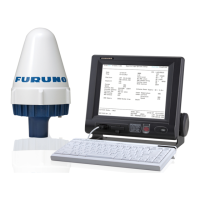3. SYSTEM INITIALIZATION
3-8
3.4 EGC Settings
3.4.1 What is the EGC (Enhanced Group Call) service?
The EGC service enables EGC information providers to send SafetyNET
TM
, Fleet-
NET
TM
and System messages via an LES to a specific groups of ships, or to all ships
within a defined geographical area.
Each type of EGC service is sent as follows:
There are three types of EGC services:
1) SafetyNET
TM
This provides a means for information providers to distribute Maritime Safety Infor-
mation (MSI) from shore-to-ship. Authorized information providers include:
2) FleetNET
TM
This service allows authorized information providers such as commercial subscrip-
tion services, shipping companies and governments, which have registered with a
LES that supports FleetNET
TM
, to broadcast messages to selected group of
MESs. Typical applications of FleetNET
TM
are
• The information provider prepares the message, and then accesses the appro-
priate Country of the international telex network to send the message to an LES.
• The LES processes and forwards it to the NCS for the ocean region designated
by the provider.
• Then, the NCS broadcasts the message throughout the ocean region. (The op-
erator may select the EGC messages to receive by position (one position) and
geographical position (nine areas). For further details see
section 3.4.2.)
• Hydrographic Offices, for navigational warnings
• National Weather Services, for meteorological warnings and forecasts
• Rescue Co-ordination Center, for shore-to-ship distress alerts and other urgent infor-
mation
•
International Ice Patrol, for North Atlantic ice hazards
• Fleet or company broadcasts
• News broadcasts
• Commercial weather service
• Government broadcasts to all vessels on a country’s registration
Satellite
NCS common channel
MES
MES
MES
NCS
Ch1
Ch2
Ch3
LES1
LES2
LES3
Ch1-Ch3 are dedicated
channels for each LES.
Information Provider
* Meteorological body
* Navtex station
* Coast guard
* Rescue center
* Shipping company, etc.

